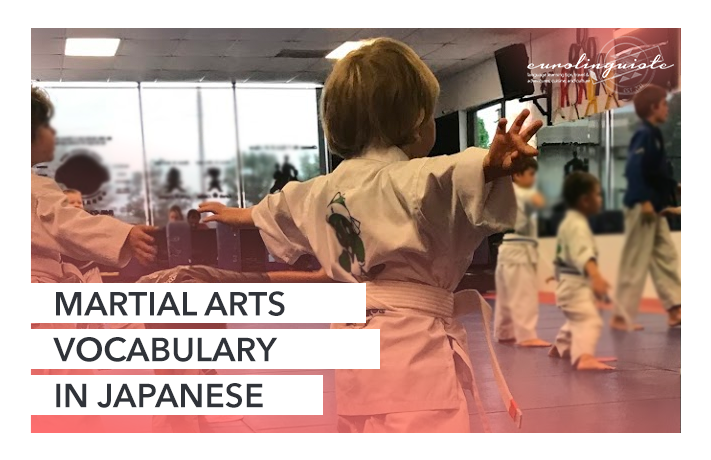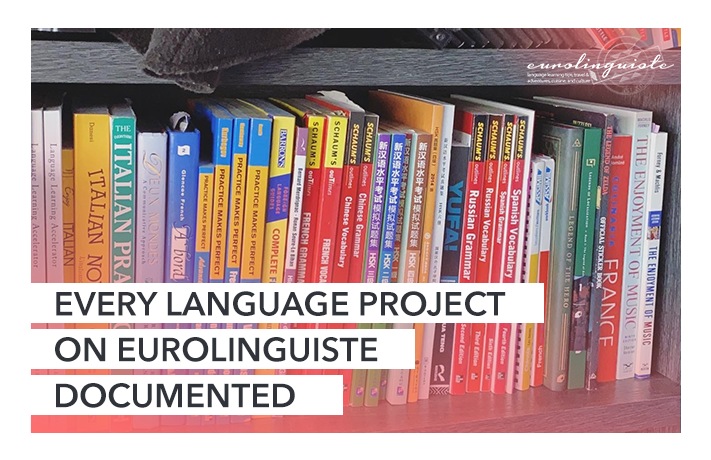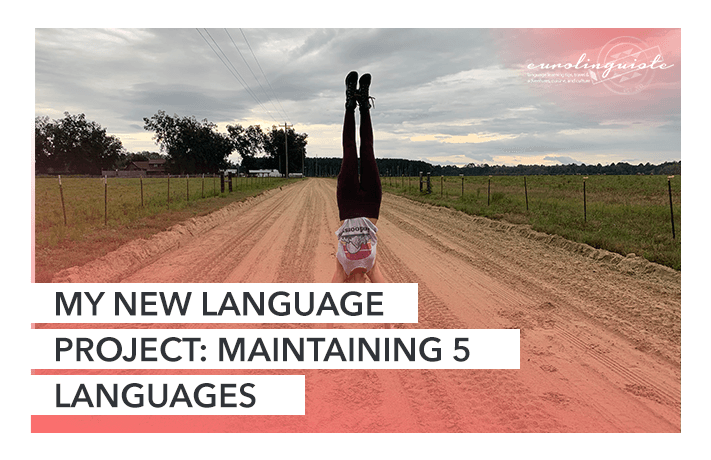Martial Arts Vocabulary in Japanese: Learn How to Talk about Karate in Japanese

My name is Shannon Kennedy and I'm the language lover,…
Earlier, I wrote a post that featured taekwondo vocabulary in Korean, sharing my interest and history in martial arts. Initially, I started with karate before moving to kickboxing and later kungfu, only to finally settle at a school that teaches both taekwondo and karate. The former a Korean practice and the latter, Japanese.
Because the school teaches a blend of Japanese and Korean arts, commands are given in both languages. We’re asked to move into ready stance in Korean, but told to bow to the flags and black belts in Japanese.
As I shared in my taekwondo vocabulary post, kinesthetic learning, that is, tying learning to movement, is a powerful way to learn a new words in a language. Particularly because not following commands in class meant having to do push-ups, and I hate push-ups. So knowing what I’m being asked to do in Japanese and Korean is paramount to avoiding those extra push-ups.
And if you’d like to learn more Japanese karate words, Drops recently released several hundred new words to help you learn how to talk about Japanese culture. The topics cover everything from food to traditions and even–you guessed it–karate!
Karate Vocabulary in Japanese
The Japanese word karate in Kanji, or Chinese characters, is 空手 (karate). It might also be called 空手道 (karate-do). This literally means “empty hand”. It’s name is a clue to it’s style!
But before we get into specific vocabulary, first, let’s learn the basics! Here are a few branches of Japanese martial arts in Japanese.
Types of Japanese Martial Arts Vocabulary
- 古流 (こりゅう, koryu): traditional school, today this is most often referred to as bujutsu (武術)
- 相撲 (すもう, sumo): sumo, a martial arts form dating back to the 8th century that uses throwing and grappling techniques. Listen to how sumo is pronounced in Japanese.
- 柔術 (じゅうじゅつ, jūjutsu): jujutsu, a martial art focused on throwing over punching or kicking. Listen to how jujutsu is pronounced in Japanese.
- 剣道 (けんどう kendou): kendo, the art of the sword. Listen to how kendo is pronounced in Japanese.
- 柔道 (じゅうどう, jūdou): judo, a grappling-focused martial art. Listen to how judo is pronounced in Japanese.
- 合氣道 (あいきどう, aikidou): aikido, an art that blends into the movements of the attacker rather than fighting force with force. Listen to how to pronounce aikidou in Japanese.
- 空手 (からて, karate): karate, an art that focuses on striking and kicking. Listen to how karate is pronounced in Japanese.
Keywords for Japanese Martial Arts
And here are a few more key terms including, the Japanese words for those who practice martial arts, the locations, etc. In this list, you’ll learn the word for instructor is sensei in Japanese. It’s worth going further with this particular Japanese translation. The word sensei is used for instructors and teachers but it literally means “the one who comes before in life”. This meaning is beautiful–it implies that we learn from those who come before us. Your karate sensei has already walked the path you are learning now!
- Master Instructor: 先生 (せんせい, sensei) learn how to pronounce sensei in Japanese
- Senior Student: 先輩 (せんぱい, senpai)
- Karate Practicioner: 空手家 (からてか, karateka)
- Dojo: 土壌 (どじょう, dojou) listen to how to pronounce dojo in Japanese
- Uniform: ぎ (gi)
- Belt: 帯 (おび, obi) here’s how to pronounce obi in Japanese
- Belt grades: どん (don) hear how to pronounce don in Japanese
- Kiyah!: 気合 (きあい, kiai) this is yell done by martial arts practitioners when striking or kicking to help with power. Listen to how to pronounce kiyah in Japanese
- Dojo code: 土壌くん (どじょうくん, dojou kun), the code followed in a particular dojo
- Oss: おす (osu), a respectful, catchall phrase said when bowing or to acknowledge a command
Basic Japanese Words You Should Know
If you study martial arts in a school where Japanese is spoken, there’s a good chance you’ll hear some of these words:
- Hello: こんにちは (konnichiwa) hear how to say hello in Japanese
- Yes: はい (hai) hear how to say yes in Japanese
- No :いいえ (iiye) hear how to say no in Japanese
- Please: どうぞ (douzo), this also means “go ahead”
- Thank you (informal): ありがとう (arigatou), likely the instructor or senior student would use this with other students.
- Thank you (formal): ありがとうございます (arigatou gozaimasu), for students to use with instructor or senior students. Hear how to say thank you in Japanese.
- I (also: me): 私 (わたし, watashi) hear how to say I in Japanese
- You: あなた (anata) hear how to say you in Japanese
Karate Commands in Japanese
- Attention: きおつけ (kiotsuke)
- Begin: はじめ (hajime)
- Ready: よい (yoi)
- Stop: やめ (yame)
- Bow: れい (rei)
- Kneel: 正座 (せいざ, seiza)
- Move to ready position: 構えて (かまえて, kamaete)
- Turn (around): 回って (まわって, mawatte)
- One more time: もう一度 (もういちど, mou ichi do)
Karate Stances in Japanese
- Stance: だち (dachi)
- Natural stance: 兵こだち (へいこだち, heiko dachi)
- Informal stance: 結びだち (むすびだち, musubi dachi)
- Straddle stance: きばだち (kiba dachi)
- Back stance: こくつだち (kokutsu dachi)
- Cat stance: 猫だち (ねこだち, neko dachi)
- Feet together stance: 閉塞だち (へいそくだち, heisoku dachi)
- Front stance: 前屈だち (ぜんくつだち, zenkutsu dachi)
- Sumo stance: しこだち (shiko dachi)
Body Parts Used in Karate in Japanese
- Abdomen: ふくぶ (fukubu) listen to this word
- Ankle: 足首 (あしくび, ashikubi) listen to this word
- Arm: うで (ude) listen to this word
- Elbow: ひじ (hiji) listen to this word
- Foot: あし (ashi) listen to this word
- Hand: て (te) listen to this word
- Head: 頭 (あたま, atama) listen to this word
- Knee: 膝 (ひざ, hiza) listen to this word
- Leg: あし (ashi) listen to this word
- Back:後ろ (うしろ, ushiro)
- Throat: 喉 (のど, nodo) listen to this word
- Wrist: てくび (tekubi) listen to this word
- Heel: かかと (kakato) listen to this word
Basic Karate Technique Terms in Japanese
- Basic Technique: きほん (kihon)
- Block: 受けうけ (uke)
- Chi: き (ki)
- Cross-legged sitting position: あんざ (anza)
- Focus: 決めきめ (kime)
- Form: かた (kata) listen to how kata is pronounced in Japanese
- Form starting point: えんぶせん (enbusen)
- Form Technique Application: ぶんかい (bunkai)
- Karate mats: 畳 (たたみ, tatami) hear how tatami is said in Japanese
- Kick: げり(keri), please note that this pronunciation changes to (-geri) when following another word but is said with a “k” sound when alone
- Kneeling Technique: せいざわざ (seiza waza)
- Punch: つき (tsuki)
- Snap: けあげ (keage)
- Sparring: 組手くみて (kumite)
- Strike: うち (uchi)
- Sweep: ばらい (barai)
- Technique: わざ (waza)
- Throw: 投げなげ (nage)
- Thrust: けこみ (kekomi)
States of Mind in Japanese Martial Arts
- Martial state of mind: ざんしん (zanshin)
- Meditation: もくそ (mokuso)
- No Mind: むしん (mushin)
Directions for Karate in Japanese
- Back: うしろ (ushiro)
- Front: 前まえ (mae)
- Side: よこ (yoko)
- Right: 右みぎ (migi)
- Left: 左ひだり (hidari)
- Low: げだん (gedan)
- Middle: ちゅだん (chudan)
- High: じょだん (jodan)
Block Techniques in Japanese
Earlier you learned that 受け is “block” in Japanese. It’s literal meaning is “receive”. This is because when blocking a punch or kick, you aren’t trying to stop it with brute force. Instead, you’re receiving it. Thinking of the blocking technique in this way will help you better executre your blocks.
- Downward block: げだんばらい (gedan barai)
- Outside block: そとうけ (soto uke)
- Inside block: うちうけ (uchi uke)
- X block: じゅじうけ (juji uke)
- Rising block: あげうけ (age uke)
- Knife hand block: しゅとうけ (shuto uke)
- Verticle knife hand block: たてしゅとうけ (tate shuto uke)
- Sweeping block: ながしうけ (nagashi uke)
- Back Hand block: はいしゅうけ (haishu uke)
- Elbow block: えんぴうけ (enpi uke)
- Augmented block: もろてうけ (morote uke)
- Wedge block: かけわけうけ (kakewake uke)
Japanese Word for Sparring Techniques
“Sparring” in Japanese is kumite. This word literally means “entangled hands”. Here are a few “entangled hands” techniques in Japanese.
- Basic one-step sparring: 基本一本組手 (きほんいっぽんくみて, kihon ippon kumite)
- Three-step sparring: 三本組手 (さんぼんくみて, sanbon kumite)
- Five-step sparring: 五本組手 (ごほくみて, gohon kumite)
- Semi-free style sparring: 地涌いっぽん組手 (じゆいっぽんくみて, jiyu ippon kumite)
- Free-style sparring: 地涌組手 (じゆくみて, jiyu kumite)
- Reaction sparring: 開始一本組手 (かいしいっぽんくみて, kaishi ippon kumite)
More Kicks in Japanese
- Roundhouse kick: まわしげり (mawashi geri)
- Knee kick: ひざげり (hiza geri)
- Side thrust kick:よこげりけこみ (yoko geri kekomi)
- Side snap kick: よこげりけあげ (yoko geri keage)
- Kicking combinations: れんげり (ren geri)
Punches & Strikes in Japanese
- Straight punch: からつき (kara tsuki)
- Stepping punch: おいつき (oi tsuki)
- Front hand punch: きざみつき (kizami tsuki)
- Reverse punch: ぎゃくつき (gyaku tsuki)
- Hook punch: かぎつき (kagi tsuki)
- Two punch combo: れんつき (ren tsuki)
- Hammer fist: てついうち (tetsui uchi)
- Back fist: うらけんうち (uraken uchi)
- Ridge hand: はいとうち (haito uchi)
- Knife hand: しゅとうち (shuto uchi)
- Spear hand: ぬきて (nukite)
- Elbow strike: えんぴうち (enpi-uchi)
- Reverse elbow strike: うしろえんぴうち (ushiro enpi uchi)
- Return hands to ready position: ひきて (hikite)
Now it’s your turn. Practice these words and expressions, and if you’re in karate or another branch of Japanese martial arts, see if you recognize any of them! You can also look up instructional videos for karate in Japanese to test your new vocabulary. This will help you instill these terms in Japanese.
If you’re ready to take what you’ve learned to the next level, you can combine these terms to talk about combos in karate. And you’ll get to chat about one of your hobbies – martial arts – in Japanese.
What about you? Are there any karate-related words or phrases you’ve picked up in Japanese? Let me know!
And if you’d like to learn more words like this in Japanese, don’t forget to check out Drops. A fun, engaging way to learn new Japanese words in just 5 minutes a day.
My name is Shannon Kennedy and I'm the language lover, traveler, and foodie behind Eurolinguiste. I'm also the Head Coach of the Fluent in 3 Months Bootcamp, co-founder of Women in Language, and former Resident Polyglot at Drops.







